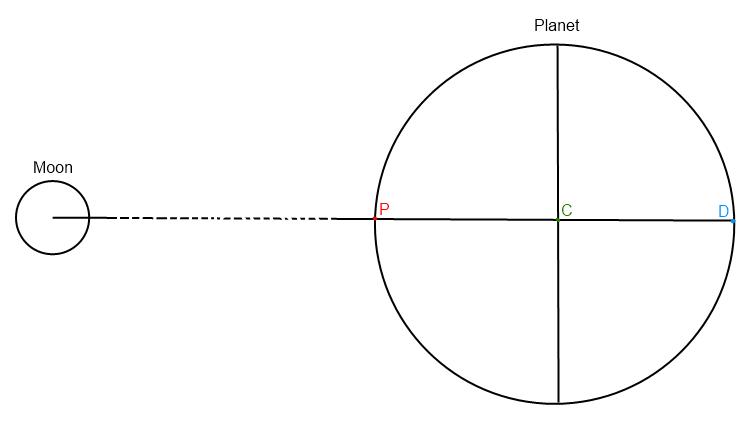Slapové jevy
[CZ] Nápad na tuto cache jsem dostal, když jsem jednou šel na procházku z Trura do Malpasu (Anglie, oblast Cornwall). Cesta vedla kolem reky, která nebyla jen tak obycejná reka, byl to vlastne morský záliv. Do té doby jsem pokaždé videl, jak zde voda tekla v úzkém proudu logicky z kopce dolu. Tentokrát se ale valila z mého pohledu nahoru.




Puvodne jsem chtel cache umístnit práve v Truru. Jelikož jsem v Británii byl ale jen na chvíli, rozhodl jsem se ji realizovat zde, u Džbánu. Je to jedna z nejvetších vodních ploch v Praze (a je nedaleko mého príbytku), takže je tu hypoteticky vysoká pravdepodobnost, že zde zastihnete v akci príliv (i když to je na to asi opravdu trochu malá).
Na slapových jevech je zajímavé, že se nemusí projevovat jen na mori, ci oceánu, ale jsou dokonce do urcité míry pozorovatelné i na nejvetších jezerech sveta (Horejší, Michiganské, Erijské jezero ...). A ne jen to! Voda není také zdaleka jediná hmota, která podléhá vlivu gravitacní síly mesíce - v urcitém rozmezí se zvedá a klesá také celá litosféra (v centrální Evrope to muže cinit až 30cm)!
Zajímavé je, že Slunce, ac na nás pusobí mnohem vetší silou než Mesíc, nemá na príliv a odliv tak zásadní vliv. Proc? (To je dobrovolná otázka, pro ty, co si tuto cache opravdu vypocítají a pokusí se celému „problému” trošku porozumet). Vaše prípadné návrhy si pak rád prectu, pošlete mi je prosím zprávou pres profil. Do logu to nepište, at zbytecne nenapovídáte ostatním.
Také stojí za zmínku, že na slapové jevy mají vliv vlastne všechna vesmírná telesa, tedy i ostatní planety, ale povetšinou je jejich vliv zanedbatelný. Mohou se ale projevit v prípade, kdy je více vesmírných teles v jedné rade. Víc zajímavých vecí už ale neprozradím. Pro toho, kdo zná tuto problematiku, jsou asi už i predešlé rádky jen nošením dríví do lesa. Tomu, kdo to nezná (jako jsem byl treba i já :-) ), by to mohlo zacít napovídat a to by se pak pripravil o tu zábavu obstarávání si informací na vlastní pest :-)
Z duvodu uvedených v logu zde naleznete 2 zadání - staré, barevne odlišené, které není špatné po matematické stránce, ale fyzikálne je trochu nesmyslné, nicméne si myslím, že je o neco jednodušší a bylo již otestováno. Nové zadání, které jsem se snažil udelat fyzikálne "smyslnejší"  , je podle mého názoru o neco nárocnejší. VÝSLEDEK, který je treba výpoctem zjistit, JE každopádne v obou prípadech STEJNÝ. Mužete si tedy vybrat sami pro Vás schudnejší variantu a do logu pak kdyžtak uvedte, kterou cestou jste se vydali
, je podle mého názoru o neco nárocnejší. VÝSLEDEK, který je treba výpoctem zjistit, JE každopádne v obou prípadech STEJNÝ. Mužete si tedy vybrat sami pro Vás schudnejší variantu a do logu pak kdyžtak uvedte, kterou cestou jste se vydali 
Predstavte si planetu, která je velikostne podobná naší Zemi. Predpokládejme, že je zcela kulatá a celou ji kryje 1 km tlustá vrstva ideální kapaliny. Hmotnost planety je 6x10
24 kg a polomer až po hladinu kapaliny je 6,4x10
6 m. Na rozdíl od Zeme má 2 mesíce. Oba jsou stejne veliké (polomer každého je 3,5x10
6 m.), mají stejnou hmotnost (7,5x10
22 kg) a obíhají po svých orbitálních drahách. v centru planety by se dalo zjistit gravitacní zrychlení zpusobené obema mesíci o hodnote 1,08377x10
-4 m/s
2.
Planeta je rozdelena na 360 poledníku a 180 rovnobežek, podobne jako naše Zeme a otácí se kolem své osy jednou za 24 h. Imaginární postava sedí v lodce na této planete zhruba v techto místech - N50° 15.704’, W5° 03.267‘. Ve 14:00 si všimla, že jeden mesíc se nachází nad 23. poledníkem, druhý nad 323 a oba se nacházeli zrovna na úrovni rovníku. Vypadalo to približne takto:
 Pokracování pod cerveným textem ...
-------------------------------------------------------------------------------------
Pokracování pod cerveným textem ...
-------------------------------------------------------------------------------------
Predstavte si planetu o velikosti naší Zeme zcela pokrytou vodou. Abychom to zbytecne nekomplikovali, predpokládejme, že tato planeta je perfektní koule a voda na jejím povrchu je ideální kapalina dosahující hloubky 1km. Na rozdíl od Zeme, má tato planeta 2 mesíce. Oba jsou stejne veliké, stejne váží, obíhají po stejné kruhové obežné dráze rovnobežné s rovníkem planety ve vzdálenosti 400 000km. V tomto prípade klesá gravitacní pole mesícu lineárne.
(Poznámka: Samozrejme, že síla gravitacního pole klesá v reálu približne se ctvercem vzdálenosti a tudíž není lineární, ale pro tento model jsem to zámerne zmenil, abych usnadnil výpocty. Bude to takto naprosto stacit.)
Gravitacní pole každého z mesícu pak bude vypadat takto:

Body P (proximální), C (centrální) a D (distální), predstavují 3 zarízení, která v daném míste merí zrychlení, které je zpusobené ciste jen gravitacním polem daného mesíce. Pro každý jednotlivý mesíc pak vychází tyto hodnoty:
agP = 3 m/s2; agC = 2 m/s2; agD = 1 m/s2
Oba mesíce cestují vesmírem stejnou rychlostí, takže se jejich vzájemná vzdálenost nemení.
Vezmeme v úvahu následující situaci: Planeta je rozdelena na poledníky a rovnobežky, podobne jako Zeme, a také se kolem své osy otocí jednou za 24h. Imaginární postava sedí v lodce na této planete zhruba v techto místech - N50° 15.704’, W5° 03.267‘. Ve 14:00 si všimla, že jeden mesíc se nachází nad 23. poledníkem a druhý nad 323. Vypadalo to približne takto:
 -------------------------------------------------------------------------------------
-------------------------------------------------------------------------------------
Nebyla tu ale žádná pevnina, na které by šel pozorovat príliv a odliv, tak se clovícek v lodce ptal sám sebe: “Kolik asi je ted zrovna na této planete prílivu a odlivu na úrovni rovníku? Jak jsou asi veliké? Na kterých polednících bych zrovna mel být, abych se na nich mohl svézt?
A to jsou take otázky pro Vás. Na kterých polednících v oblasti rovníku jsou v této situaci k najití vrcholy prílivu? Kolik takovýchto vrcholu na celé planete zrovna je?
(Pokud Ti vyjde, že se nejaký vrchol nachází na 0°, respektive 360°, pocítej to prosím jako 360°).
PS: Nezapomente na dobrovolnou otázku – Proc Slunce neovlivnuje príliv a odliv do takové míry jako Mesíc?
Pokud máš vše spocteno, tady je návod, co s tím:
Secti císelné hodnoty poledníku na nichž se nachází vrcholy prílivu => petimístné císlo
ABCDE(pokud náhodou nekterého z rádu nebylo dosaženo dopln jej nulou; pr.: výsledný soucet je 1235 => A=0, B=1, C=2, D=3, E=5)
Pocet vrcholu prílivu =>
F
Ciferace ABCDE =
G
A pro kontrolu A
2+ B
2+ C
2+ D
2+ E
2+ F
2+ G
2= 85
Sedí to? Takže výsledné souradnice jsou:
N 50° 05.{E}{G+F-C}{C-D}’
E 14° 19.{GA+FB+E/D}{A*C-B*D+E+G-F/2}{F}‘
Tide
[EN] Once when I was in Britain in Truro, I had a walk to Malpas. I strolled down a nice path right next to, some may say, river. However, it was more like a bay or fjord that looked like a river. Most of the time I saw a litle stream floating down, however this day I saw a huge amount of water hurrying up. This made me think about this cache.




Since I had to leave Truro few days later I just decided to materialize the cache over here, near to Džbán, which is one of the biggesr water reservoirs in Prague. Therefore there is high probability that you will be able to notice high or low tide in action.
There is the thing about the tide that it doesnt affect seas oceans only, but it is noticeable on the world’s largest lakes (Superior Lake, L. Erie, Michigan L. …). What’s more, water is not the only matter affected by the gravitation force of the Moon – even litospheric layer is rising and descending in the rythm of the circling Moon into some extent (in central Europe it can be up to 30cm). One more fun fact about the tide – the Sun is not affecting this process even though its force is much greater that the gravitation force of the Moon. Do you have an idea why? (By the way, this is a voluntary question for those who will calculate this and who will try to understand it a bit). Your tips and thoughts are welcome, send them please via message link in my profile, so you dont give away any hints for others.
It is also worht mentioning that tide is affected even by planets, but their effect on tide is very small. However, it can be noticed while they are lined up. I will not tell you more interesting information since people educated in this field are probably bored already and for those, who are getting into it (the same was me :-) ), it might give them some clues. Therefore they would be deprived of the fun of finding information by themselves :-)
You can find 2 a bit different settings, the reasons is described in the log. Old one (it has different color) isn't mathematically incorrect, but physically it is more or less nonsence, even though it is a bit easier, from my point of view. New setting should make more sence from physical point of view, however, I would say that it is a bit more advanced. Either way, RESULTS, that you need to calculate, ARE THE SAME in both cases. Therefore it is absolutely up to you which one you choose. If you remember, could you write into the log which way you had chosen, please? 
Imagine a planet, that is similar to the Earth. Lets consider that it is perfectly round and covered by a layer of ideal liquid 1 km thick. Weight of the planet is 6x1024 kg and radius is 6,4x106 m from the center to the surface of the liquid. This planet has 2 moons. Both of them are of the same size (radius of each of them is 3,5x106 m.), they are of the same weight (7,5x1022 kg) and they are on their orbits. Summed up gravitation acceleration of both moons in the center of the planet is 1,08377x10- 4 m/s2.
The planet is divided into 360 meridians and 180 circles of latitude similar to Earth and it spins once per 24h. Imaginary person sitting on the boat on this planet with GPS coordinates about N50° 15.704’, W5° 03.267‘ noticed that at 14:00 one moon was at the position of 23rd meridian, the other one at the position of 323rd meridian and both of them were above the equator. It looked somehow like this:

Continue behind the red text ...
-------------------------------------------------------------------------------------
Well, now l'ets get down to business. Imagine a planet as big as our Earth completely covered by water. Let's make it really simple and let's assume that the planet is a perfect ball and the water on the top of it is ideal liquid, 1km deep. This planet has, unlike Earth, 2 moons. Both of them are of the same size, weight, they both travel on the same circle orbit parallel to equator 400,000km away from the planet. In this particular model gravitational fields of these moons fade linearly.
(Note: Of course, gravitational field decreases approximately with the square of the distance, therefore in real world it is NOT linear. However, for this situation I made it linear because this way it is much simpler to calculate it and for this particular model it will do just OK)
A gravity field of each moon could be illustrated like this:

Points P (proximal), C (central) and D (distal) represents 3 devices that are measuring acceleration produced by gravitational field of particular moon. Their measurements for each one moon separately would be:
agP = 3 m/s2; agC = 2 m/s2; agD = 1 m/s2
Both moons are travelling at the same speed therefore the distance between them is still the same.
Let's consider a hypothetical situation: The planet is divided into meridians and circles of latitude, like Earth and it spins once per 24h. Imaginary person sitting on the boat on this planet with GPS coordinates about N50° 15.704’, W5° 03.267‘ noticed that at 14:00 one moon was at the position of 23rd meridian and the other one at the position of 323rd meridian. It looked somehow like this:
 -------------------------------------------------------------------------------------
-------------------------------------------------------------------------------------
Because there was no ground to see the tide, he asked himself: „How many high and low tides are there on this planet now? How big they might be? At which meridians can I find their peaks?“
And this is also a question for you. At which meridians can you find peaks of high tides in this particular situation? How may of them are there?
(If you find any at 0° or 360°, what is basically the same meridian, count it as 360°.)
PS: Don't forget about the optional question, why is the Sun affecting tide less than the Moon.
If you have done your calculations, here is the procedure to find the cache:
Sum up the numerical values of the meridians with the high tide peaks => fill in five-digit number ABCDE(if you count less digits, complete the number with zero; example.: the result is 1235 => A=0, B=1, C=2, D=3, E=5)
Number of the peaks => F
Ciphering (digital root) of ABCDE = G
Just to make sure that you have it right, A2+ B2+ C2+ D2+ E2+ F2+ G2= 85
And final coordinates are:
N 50° 05.{E}{G+F-C}{C-D}’
E 14° 19.{GA+FB+E/D}{A*C-B*D+E+G-F/2}{F}‘
